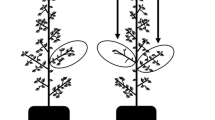Abstract
The performance of gypsy moths (Lymantria dispar) feeding on quaking aspen (Populus tremuloides) is strongly influenced by host foliar chemistry and susceptibility to a nuclear polyhedrosis virus (LdNPV), but the relationship of susceptibility to chemistry is poorly understood. We investigated the effects of genetic and resource-mediated variation in phytochemistry on viral pathogenicity. Trees were grown in pots in a common garden. Disks were punched from aspen leaves, inoculated with LdNPV and fed to third instars. Additional leaves were analyzed for levels of nitrogen, starch, phenolic glycosides, and condensed tannins. Despite marked variation among trees in levels of phenolic glycosides and tannins, we observed minimal variation in larval susceptibility to LdNPV. Viral pathogenicity was only weakly (inversely) correlated with tannin concentrations in one of two experiments. These results suggest that differential defoliation of aspen by gypsy moths in the field is due to the direct effects of host chemistry on larval performance rather than to the indirect effects of host chemistry on efficacy of this natural enemy.
Similar content being viewed by others
REFERENCES
Arteel, G. E., and Lindroth, R. L. 1992. Effects of aspen phenolic on gypsy moth (Lepidoptera: Lymantriidae) susceptibility to Bacillus thuringiensis. Great Lakes Entomol. 25:239-244.
Elkinton, J. S., and Liebhold, A. M. 1990. Population dynamics of gypsy moth in North America. Annu. Rev. Entomol. 35:571-596.
Foster, M. A., Schultz, J. C., and Hunter, M. D. 1992. Modelling gypsy moth-virus-leaf chemistry interactions: Implications of plant quality for pest and pathogen dynamics. J. Anim. Ecol. 61:509-520.
Hagerman, A. E., and Butler, L. G. 1980. Condensed tannin purification and characterization of tannin-associated proteins. J. Agric. Food Chem. 28:947-952.
Hemming, J. D. C., and Lindroth, R. L. 1995. Intraspecific variation in aspen phytochemistry: Effects on performance of gypsy moths and forest tent caterpillars. Oecologia 103:79-88.
Hemming, J. D. C., and Lindroth, R. L. 1999. Effects of light and nutrient availability on aspen: growth, phytochemistry and insect performance. J. Chem. Ecol. In press.
Hoover, K., Stout, M. J., Alaniz, S. A., Hammock, B. D., and Duffey, S. S. 1998. Influence of induced plant defenses in cotton and tomato on the efficacy of baculoviruses on noctuid larvae. J. Chem. Ecol. 24:253-271.
Hunter, M. D., and Schultz, J. C. 1993. Induced plant defenses breached? Phytochemical induction protects an herbivore from disease. Oecologia 94:195-203.
Hwang, S.-Y., and Lindroth, R. L. 1997. Clonal variation in foliar chemistry of aspen: Effects on gypsy moths and forest tent caterpillars. Oecologia 111:99-108.
Hwang, S.-Y., and Lindroth, R. L. 1998. Consequences of clonal variation in aspen phytochemistry for late season folivores. Ecoscience. 5:508-516.
Hwang, S.-Y., Lindroth, R. L., Montgomery, M. E., and Shields, K. S. 1995. Aspen leaf quality affects gypsy moth (Lepidoptera: Lymantriidae) susceptibility to Bacillus thuringiensis. J. Econ. Entomol. 88:278-282.
Keating, S. T., Yendol, W. G., and Schultz, J. C. 1988. Relationship between susceptibility of gypsy moth larvae (Lepidoptera: Lymantriidae) to a baculovirus and host plant foliage constituents. Environ. Entomol. 17:952-958.
Keating, S. T., Hunter, M. D., and Schultz, J. C. 1990. Leaf phenolic inhibition of gypsy moth nuclear polyhedrosis virus. J. Chem. Ecol. 16:1445-1457.
Lang, C. A. 1958. Simple microdetermination of Kjeldahl nitrogen in biological materials. Anal. Chem. 30:1692-1694.
Lindroth, R. L., and Hwang, S.-Y. 1996a. Diversity, redundancy and multiplicity in chemical defense systems of aspen. Recent Adv. Phytochem. 33:25-56.
Lindroth, R. L., and Hwang, S.-Y. 1996b. Clonal variation in foliar chemistry of quaking aspen (Populus tremuloides Michx.). Biochem. Syst. Ecol. 24:357-364.
Lindroth, R. L., Kinney, K. K., and Platz, C. L. 1993. Responses of deciduous trees to elevated atmospheric CO2: Productivity, phytochemistry and insect performance. Ecology 74:763-777.
Lindroth, R. L., Roth, S., Kruger, E. L., Volin, J. C., and Koss, P. A. 1997. CO2-mediated changes in aspen chemistry: Effects on gypsy moth performance and susceptibility to virus. Global Change Biol. 3:279-289.
Parkinson, J. A., and Allen, S. E. 1975. A wet oxidation procedure suitable for the determination of nitrogen and mineral nutrients in biological material. Commun. Soil Sci. Plant Anal. 6:1-11.
Porter, L. J., Hrstich, L. N., and Chan, B. G. 1986. The conversion of procyanidins and prodelphinidins to cyanidin and delphinidin. Phytochemistry 25:223-230.
Price, P. W., Bouton, C. E., Gross, P., McPheron, B. A., Thompson, J. N., and Weis, A. E. 1980. Interactions among three trophic levels: Influence of plants on interactions between insect herbivores and natural enemies. Annu. Rev. Ecol. Syst. 11:41-65.
Roth, S., Knorr, C., and Lindroth, R. L. 1997. Dietary phenolics affect performance of the gypsy moth (Lepidoptera: Lymantriidae) and its parasitoid Cotesia melanoscela (Hymenoptera: Braconidae). Environ. Entomol. 26:668-671.
SAS Institute. 1988. SAS User's Guide: Statistics. SAS Institute Inc., Cary, North Carolina.
Author information
Authors and Affiliations
Rights and permissions
About this article
Cite this article
Lindroth, R.L., Hwang, SY. & Osier, T.L. Phytochemical Variation in Quaking Aspen: Effects on Gypsy Moth Susceptibility to Nuclear Polyhedrosis Virus. J Chem Ecol 25, 1331–1341 (1999). https://doi.org/10.1023/A:1020926809508
Issue Date:
DOI: https://doi.org/10.1023/A:1020926809508




